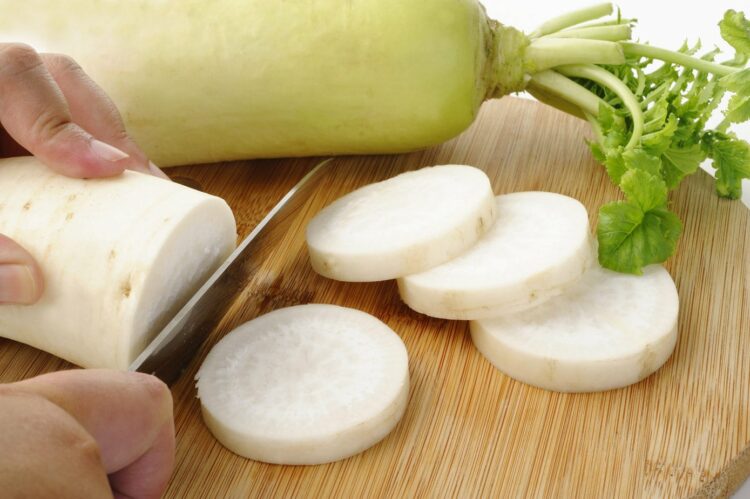What is the daikon radish?
Also called “white radish,” “Japanese radish,” or “Chinese radish,” the daikon is a staple of Japanese cuisine. Traditionally eaten raw, cooked, or pickled, this fleshy, tube-shaped root looks like a white carrot.
The varieties of daikon
Across Asia, several daikon varieties exist. The lobak (or lo pak) radish, for example, is distinguished by a green band near its root. The Korean mu radish is similar but shorter and rounder. Both of these radishes are also spicier than the classic daikon.

If you want more colour on the plate, turn to the watermelon radish! This Chinese radish is quite surprising with its green skin on the surface and its bright pink flesh. Its striking look will add a touch of freshness to your dishes while bringing sweet, mild notes.
Daikon nutrition
One major advantage: daikon is an ally for weight loss. It is very low in calories yet still satisfying. Per 100 g of daikon, you get:
- 21 calories
- 0.7 g of protein
- 0.11 g of fat
- 1.86 g of fibre
The benefits of daikon
It is also rich in potassium, vitamin C, calcium, and magnesium. To put that in perspective, daikon delivers roughly three-quarters of the potassium found in a banana and half the vitamin C of an orange. These nutrients support wound healing, protect cells from damage, and help stabilise blood sugar levels.
How to cook with daikon?
Whether raw or cooked, the daikon always stands out. It is usually peeled, but like all radishes its skin is perfectly edible. Best of all, this radish is endlessly versatile.

Slice it thinly to garnish salads and meat dishes, dice it for stews, or grate it into marinades. Takuwan, pickled daikon, is popular across Asia as a side dish or snack and is often served at the end of a meal to aid digestion. In short, daikon deserves a place in your kitchen. Even the leaves and shoots are edible, whether tossed into salads and soups or rolled into vegetable sushi.
What does daikon taste like?
Compared with the common red radish, daikon is milder and more delicate. It still delivers a subtle peppery kick and the familiar crunchy texture. Flavour can vary by variety, with some types tasting noticeably stronger than others.
Where to buy daikon in France and Belgium?
You can easily find it in specialist grocery stores as well as major supermarkets such as Carrefour or Delhaize.
It is most readily available in winter. If you have a green thumb, you can also grow daikon at home: sow the seeds in summer or early autumn and harvest the roots in winter. That way you will have a top-quality ingredient at your fingertips!
How to store daikon?
If you plan to cook the leaves, remove them immediately and store them separately. Left unwashed, they will stay fresh in a plastic bag in the fridge for up to 3 days, so use them quickly. By contrast, cut raw daikon keeps longer.
One drawback: it can develop a strong odour, so store it in a separate compartment of your fridge. Once cooked, it will keep for only a few days in an airtight container, but when pickled it can last for up to 3 weeks.

